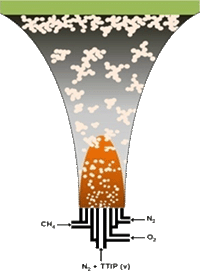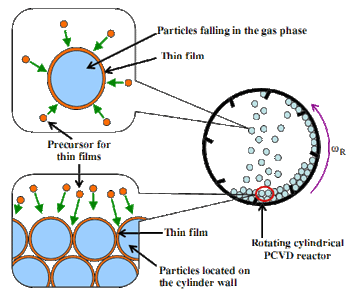|
|
|

|
| Preparation of TiO2 Particles for Photocatalysts and Its Application for Environmental Pollution Control |

Model of particle growth in
flame reactor and thin film
deposition process |
Nanoscale TiO2 particles are synthesized in the thermal plasma reactor and the flame reactor from the TTIP decomposition reaction. Those processes exhibit many benefits over other wet processes because the product particles are collected easily by filters, the post heat treatment is not required and the production rate is high. The size, phase and morphology of TiO2 are controlled through the temperature and the residence time in the reactor. The simulation by the computer fluid dynamics (CFD) program is necessary to understand the physical and chemical phenomena during the synthesis process for improving particle properties and the reactor designs.
We are developing our flame reactor to prepare the uniform TiO2 deposition on the large surface of the substrate by moving the flame torch along the X-Y directions under the substrate. The movement of particles is strongly affected by the gas velocity and thermophoresis. The particle trajectory investigation is very important to predict particle properties and to prepare uniform thin film of TiO2. |
 |
Cross-sectional view of rotating cylindrical PCVD reactor with particles
|
PCVD processes have been widely used to prepare uniform thin films for semiconductor fabrication. We analyze particle coating by a rotating PCVD reactor experimentally and coat TiO2 thin films on several substrates. The morphologies and growth rates of these thin films are depended on various process variables, such as mass flow rate of titanium tetra-isopropoxide (TTIP), applied power, reactor pressure, and rotation speed of the reactor. The particles coated with TiO2 thin films can be used as photocatalysts of high thin films efficiency and, for high efficiency of photodegradation, it is important to coat the TiO2 photocatalysts uniformly on the surface of the particles. |
|
|
|
|
|
|
